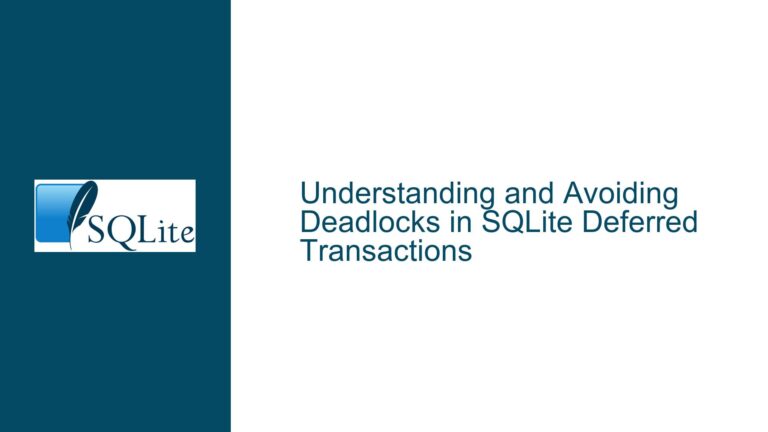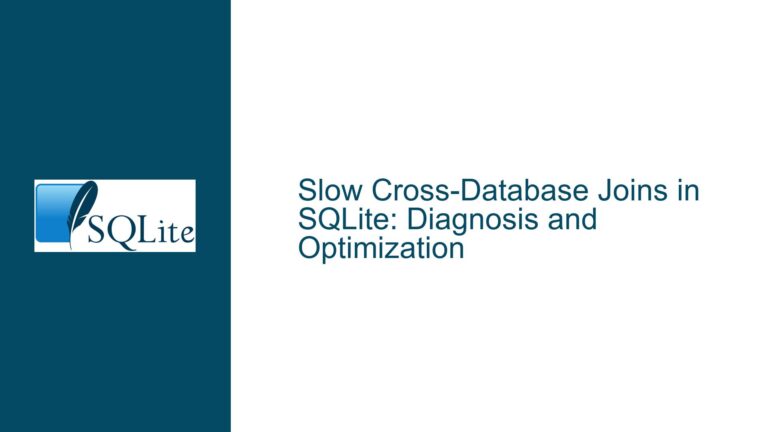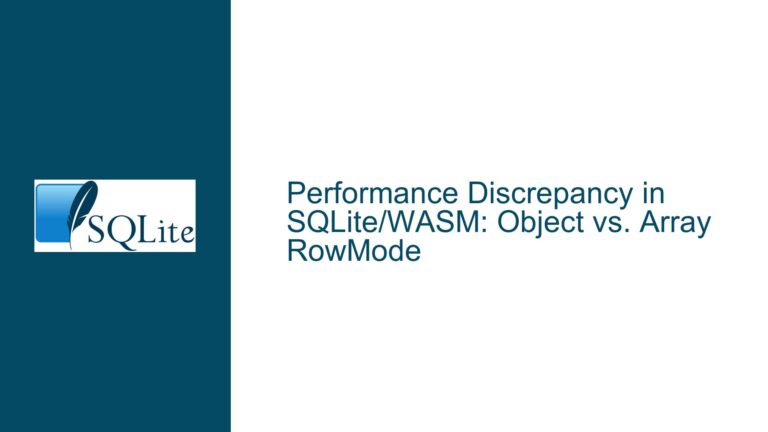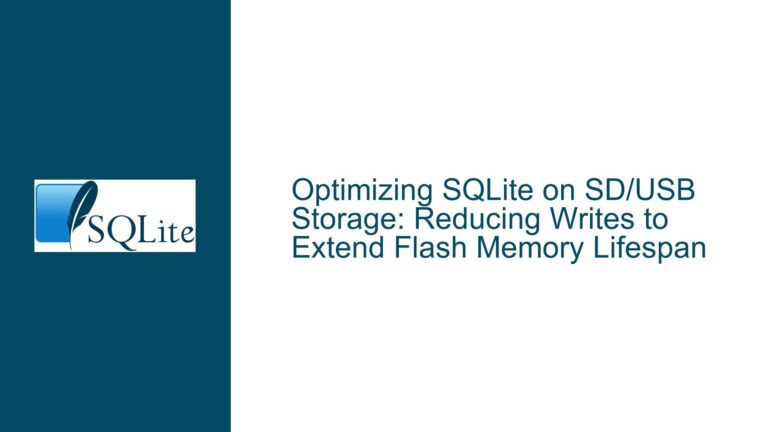Optimizing SQLite `PRAGMA integrity_check` Performance for Large-Scale ETL Processes
Understanding the Performance Bottleneck in PRAGMA integrity_check(10)
The core issue revolves around the significant time taken by the PRAGMA integrity_check(10) operation during the consolidation of over 1,000 SQLite databases into a single database. The operation is notably slower compared to other steps in the ETL process, such as SELECT and INSERT operations. On a Linux system using a remote NetApp file system, the integrity_check takes 295.170 seconds, while on a Windows system with a local SSD, it takes 74.417 seconds. This discrepancy raises questions about the efficiency of the integrity_check operation, especially given that the SELECT+INSERT operations are significantly faster (50s on Linux and 22s on Windows).
The PRAGMA integrity_check(10) command is designed to verify the integrity of the database by checking for corruption or inconsistencies. It performs a series of checks, including verifying page structures, indexes, and the overall consistency of the database. The number 10 in the command specifies the maximum number of errors to report before stopping the check. Given that the operation is I/O-intensive, its performance is highly dependent on the underlying storage system and how SQLite manages its cache.
The databases in question are in JOURNAL mode, with page sizes of either 4KB or 8KB. The JOURNAL mode, unlike WAL (Write-Ahead Logging), uses a rollback journal to ensure atomic transactions. This mode can lead to more frequent disk I/O operations, especially during integrity checks, as it requires reading and verifying each page of the database. The performance of integrity_check is also influenced by the page cache size, which determines how much data can be held in memory before needing to read from or write to disk.
Investigating the Causes of Slow integrity_check Performance
Several factors contribute to the slow performance of the PRAGMA integrity_check(10) operation. The first and most obvious factor is the underlying storage system. The Linux system, which uses a remote NetApp file system, experiences significantly slower performance compared to the Windows system with a local SSD. This is evident from the Untar benchmark, where the Linux system achieves 65.3 MB/s, while the Windows system achieves 1197.4 MB/s. The remote file system introduces additional latency and bandwidth limitations, which directly impact the I/O performance of the integrity_check operation.
Another critical factor is the page cache size. SQLite uses a page cache to store recently accessed database pages in memory, reducing the need for frequent disk I/O. However, if the cache size is too small, SQLite may experience frequent cache misses, leading to increased disk I/O and slower performance. The integrity_check operation, being I/O-intensive, is particularly sensitive to cache size. If the cache is too small, SQLite will need to repeatedly read pages from disk, resulting in slower performance. Conversely, a larger cache size can reduce the number of disk reads, improving performance.
The database’s page size also plays a role in the performance of the integrity_check operation. Databases with larger page sizes (e.g., 8KB) may experience fewer cache misses compared to those with smaller page sizes (e.g., 4KB), as more data can be stored in each page. However, larger page sizes also mean that more data needs to be read and verified during the integrity check, which can offset the benefits of reduced cache misses.
Finally, the JOURNAL mode itself can contribute to slower performance. In JOURNAL mode, SQLite uses a rollback journal to ensure atomic transactions. This mode requires more frequent disk I/O operations compared to WAL mode, which uses a write-ahead log to reduce the number of disk writes. The increased I/O operations in JOURNAL mode can slow down the integrity_check operation, especially on slower storage systems.
Strategies to Improve integrity_check Performance
To address the slow performance of the PRAGMA integrity_check(10) operation, several strategies can be employed. The first and most straightforward approach is to optimize the underlying storage system. If possible, using a local SSD instead of a remote file system can significantly improve performance, as evidenced by the benchmark results. The local SSD provides much higher read and write speeds, reducing the time required for disk I/O operations.
Another approach is to increase the page cache size. SQLite allows the page cache size to be configured using the PRAGMA cache_size command. Increasing the cache size can reduce the number of cache misses, thereby improving the performance of the integrity_check operation. However, it is essential to balance the cache size with the available system memory. Setting the cache size too high can lead to memory exhaustion, which can negatively impact overall system performance.
The database’s page size can also be optimized. While larger page sizes can reduce cache misses, they also increase the amount of data that needs to be read and verified during the integrity check. Therefore, it is crucial to find a balance between page size and cache size. For example, if the database is primarily used for read-heavy operations, a larger page size may be beneficial. However, if the database is used for write-heavy operations, a smaller page size may be more appropriate.
Switching from JOURNAL mode to WAL mode can also improve performance. WAL mode reduces the number of disk I/O operations by using a write-ahead log, which can significantly improve the performance of both read and write operations. However, switching to WAL mode requires careful consideration, as it may not be suitable for all use cases. For example, WAL mode may not be compatible with certain applications or may require additional configuration.
In addition to these strategies, it is essential to monitor and analyze the performance of the integrity_check operation. SQLite provides several tools and commands for monitoring performance, such as the PRAGMA cache_stats command, which provides information about the page cache’s performance. By analyzing this information, it is possible to identify potential bottlenecks and optimize the database’s configuration accordingly.
Finally, it is worth considering alternative approaches to integrity checking. For example, instead of performing a full integrity_check on each database, it may be possible to perform a more targeted check, focusing on specific tables or indexes that are more likely to be corrupted. This approach can reduce the time required for integrity checking while still ensuring the overall integrity of the database.
In conclusion, the slow performance of the PRAGMA integrity_check(10) operation can be attributed to several factors, including the underlying storage system, page cache size, page size, and the use of JOURNAL mode. By optimizing these factors and considering alternative approaches to integrity checking, it is possible to significantly improve the performance of the integrity_check operation, making the ETL process more efficient and reliable.






